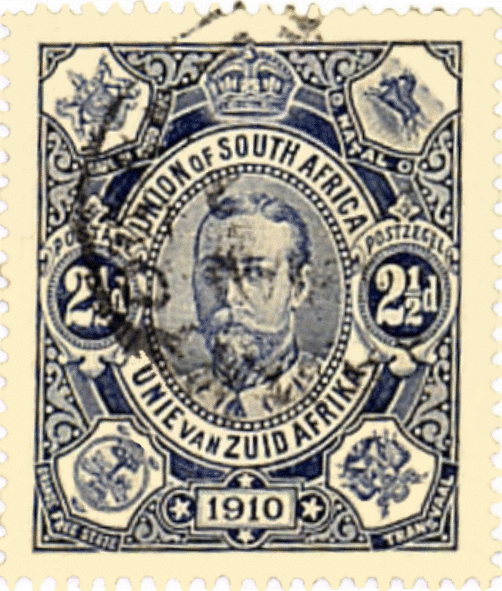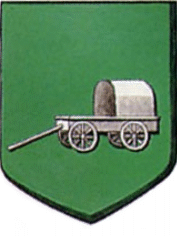

Province of Transvaal (usually called the Transvaal)
Provincie Transvaal
Grant of 1911 / Republican arms recognised 1951-57

The Province of Transvaal initially had no armorial symbol, the arms of the Zuid Afrikaansche Republiek having fallen into abeyance upon the state’s annexation by Britain as the Transvaal Colony, which lacked a coat of arms, but had other symbols which were to influence later usage.
The arms of the ZAR did, however, appear on the postage stamp issued by the Union of South Africa on 31 May 1910 to mark its inauguration.[1] Brownell[2] remarks: “From this one would logically assume that it was the intention that these arms should be resurrected as provincial arms of the Transvaal.”
About the province:
The colony formally became a province of the Union of South Africa on 31 May 1910. Pretoria was proclaimed the administrative capital of the Union, and the province’s own legislature was called the Transvaal Provincial Council. The administration was headed by an Administrator appointed by the Governor-General with the advice of the Prime Minister, assisted by an Executive Committee whose members had to be elected members of the Provincial Council.
Heraldic developments:

Arms were granted to the province by the College of Arms on 4 May 1911, in the form of the Transvaal quarter of the Union arms, but the arms so granted were not even communicated to the province (see Union of South Africa).
The arms granted in 1911 were known only to Prime Minister Louis Botha and a small circle around him. However, Deputy Prime Minister Jan Smuts was also a leading figure in the establishment of the Transvaal University College, which used these arms as part of its own armorial display.
Despite doubts as to the legitimacy of the old republican arms, there was a sentimental attachment to them. After the Orange Free State decided to adopt its old republican arms in 1937, there was a feeling that the Transvaal should follow suit.
Name of the province:
The province’s name was virtually unaffected by the recognition in 1925 of Afrikaans as having offical language status in place of Dutch, the word Provincie now being spelt as Provinsie. The province had already in 1914 acknowledged Afrikaans as a medium of instruction in schools.
Province of Transvaal
Provinsie Transvaal

Republican arms re-adopted:
Brownell writes: “In 1950 the Secretary of the Interior took up the question of provincial arms with the Prime Minister and each of the Provinces was asked to indicated which arms they desired to adopt. The Free State had reached their decision in 1937, and stuck to it. The Transvaal took a similar decision after Dr Coenraad Beyers had, at the request of the Administrator, conducted an in-depth investigation into the origin and development of the republican arms.
“On the strength of his findings a definitive painting of the arms was prepared by W H Coetzer for the Transvaal Provincial Administration. On 1 March 1951 the Transvaal petitioned the Government to arrange for these arms to be approved as the provincial arms.
“What then transpired is clearly set out in the following extract from a minute from the Secretary to the Prime Minister to the Secretary for the Interior:
‘The matter was submitted to Her Majesty the Queen, in accordance with the Prime Minister’s instructions, with the intimation that if formal approval could not be accorded to the Arms, namely, those of the Transvaal and the Orange Free State, which do not appear to conform to the laws of heraldry, without causing The Queen embarrassment and if Her Majesty would therefore prefer not to be associated with them, Ministers would not wish to take any further steps towards obtaining such formal approval. It was further untimated that, in that event, Minister proposed to seek Her Majesty’s approval for the withdrawal of the Royal Warrant of the 4th May 1911, and since it would be inappropriate to issue new Warrants in the case
of the Cape and Natal Provinces only, to give informal permission to all Four the Provinces to use the Arms which they respectively desire.
A reply has now been received from the Palace to the effect that Her Majesty will be glad to adopt the foregoing proposal whereby the Royal Warrant of the 4th May 1911, which granted arms to the Provinces which they no longer desire, is withdrawn and informal permission simultaneously given to them to use the Coats of Arms which they desire to adopt. Her Majesty feels that it is right and proper that the choice of their Coats of Arms should rest with the Provinces themselves. In these circumstances a new Royal Warrant will not be sought.
Steps are being taken for the withdrawal of the above mentioned Warrant and you will be informed when formal approval therefor has been obtained.’
“Administrators were duly informed that: ‘. . . Her Majesty the Queen has approved . . . the withdrawal, with effect from 22nd June 1954, of the Royal Warrant of the 4th May 1911, in terms of which certain Coats of Arms were granted to the Provinces. Those Provinces which have not, as yet, done so, are now at liberty to use the Coat of Arms which they desire to adopt.
“ ‘The Secretary for External Affairs states that the Garter Principal King of Arms . . . has suggested on being informed of the withdrawal of the Royal Warrant and of the permission granted to the Provinces, that the new Coats of Arms be registered with the College.’ ”
The arms of the ZAR (as painted by W H Coetzer) came into use once the 1911 Royal Warrant had been withdrawn, and appeared on the masthead of the province’s Official Gazette on 29 September 1954. The arms were recorded at the College of Arms in July 1955 and, Brownell notes, the arms “were then finally accepted by the Administrator-in-Executive-Council[3] on 8 August 1957”.
While Coetzer’s painting now became definitive, and incorporated what were seen as the best features of the late 19th-century versions of the arms, it retained two solecisms: the cartouche shape of the shield (including the hideous brass scrollwork outside the shield proper) and the eagle’s position, perched on the upper edge of the shield. The eagle nonetheless faced the dexter side, not the sinister.
At the same time a grievous error in the arms of the Union of South Africa (repeated in the 1911 grant) was corrected, at least for the Transvaal: instead of the transport wagon which first appeared in the seal of the Transvaal Colony, was placed in the 1910 grant of arms to the Union and remained there (through two changes of artwork) until the adoption of a new coat of arms in 2000, the wagon in these arms is once more one of the Voortrekker type.
A further change in the arms introduced by Coetzer is that the lion is now gardant – that is, its face is turned towards the viewer. It was gardant in the 1867 version of the arms, but its face had been turned to its own front (facing the middle of the shield) in the drawings of 1869 and ’72.
Following the promulgation of the Heraldry Act of 1962, the arms of the Transvaal Province were registered with the State Herald under certificate of registration No 3, issued on 1 March 1966. The blazon as it appears on that certificate reads:
Arms: An oval shield per fess, the chief divided per pale: dexter Gules, a natural lion contourné couchant gardant Or; sinister Azure, a bearded man in national dress wearing a hat and a bandolier, and holding in the left hand a gun resting upon the ground: in base Vert, a voortrekker wagon proper. On an inescutcheon Argent an anchor Sable cabled Gules. Perched on the shield an eagle displayed Or. Behind the shield and draped below on both sides three flags of the South African Republic, green, red, white and blue.
Motto: Eendracht Maakt Magt.
Brownell notes: “The ZAR’s ‘Vierkleur’ is protected by this registration since it is an integral part of the registered arms.”
Territorial changes:
More so than any of the other three provinces of the Union, the Transvaal included tribal trust lands in various magisterial districts, classified according to language as being Tswana-speaking, Ndebele-speaking, North Sotho-speaking,[4] Swazi-speaking, Tsonga-speaking[5] and Venda-speaking.
The Tswana homeland took its “independence” as Bophuthatswana on 6 December 1977, and the Venda homeland as the Republic of Venda on 13 September 1979.
None of the other homeland states took the “independence” offered by South Africa, but all exercised self-government to a greater or lesser extent until the end of apartheid in 1994. The administrations of these statelets continued to operate until 1995, when they were incorporated into the new provinces which had been created.
Under the 1984 Constitution the Provincial Council was abolished. The Administrator, now a presidential appointee (the prerogative having passed to the State President in 1961), now co-opted his Executive Committee instead of drawing it from elected legislators. The ostensible aim of this change was to broaden the base of the provincial administration to include people of other races (by law, only whites had been members of the Provincial Council), but by and large those appointed were lackeys of President P W Botha.
With the adoption of the post-apartheid Constitution of 1994, the Transvaal Province disappeared from the map, its place being taken by three full new provinces and roughly half of a fourth. All three of the full provinces have since changed their names. They are:
Gauteng (initially called PWV, and comprising the central region of Pretoria, the Witwatersrand and the Vaal Triangle [minus Sasolburg, which remained in the Free State]).
Mpumalanga (initially called Eastern Transvaal).
Limpopo (briefly called Northern Transvaal, then Northern Province).
The fourth province, North West, was created out of the south-western parts of the Transvaal, almost the entire Bophuthatswana and the Cape district of Vryburg (briefly the Republiek Stellaland).
